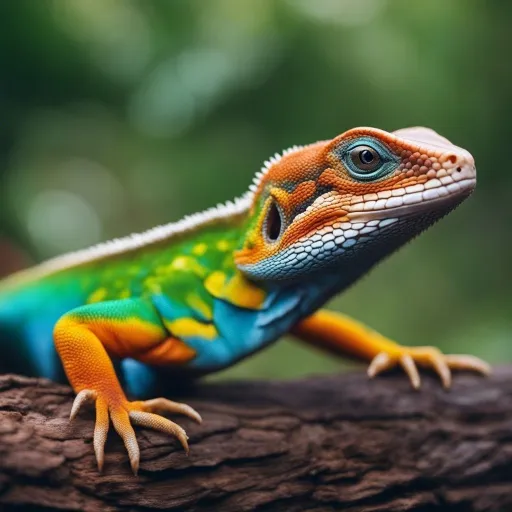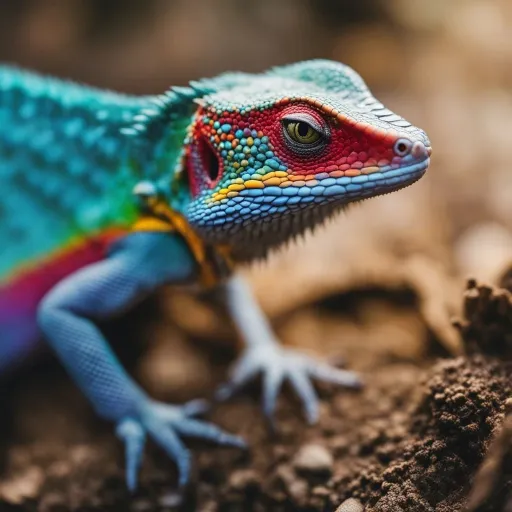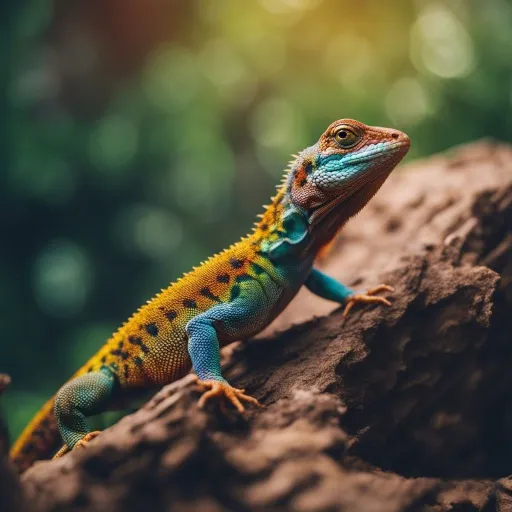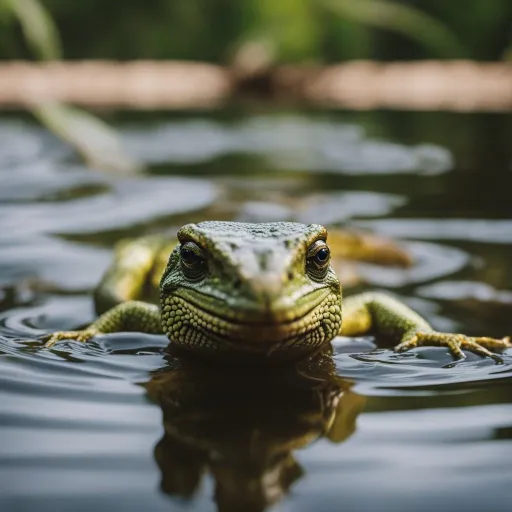You’re about to discover a fascinating world of lizards where colors morph and transform, beyond the realm of chameleons.
Have you ever wondered what other lizard species possess the astonishing ability to change colors?
This article unveils a list of mesmerizing creatures that deserve their own spotlights in the vibrant world of chromatophores.
Get ready to be amazed by the kaleidoscopic transformations of these reptilian masters of disguise.

Types of Lizards that Change Colors
Lizards are fascinating creatures known for their ability to change colors. While chameleons are the most famous color-changing lizards, there are several other species that possess this remarkable feat.
In this article, we will explore different types of lizards that are known for their color-changing abilities.
Anoles
Anoles, also known as American chameleons, are small lizards that belong to the genus Anolis.
These reptiles are native to the Americas and are commonly found in tropical and subtropical regions.
One of the most remarkable features of anoles is their ability to change colors.
Uromastyx
Uromastyx, commonly referred to as spiny-tailed lizards, are a group of lizards native to the deserts of North Africa and the Middle East.
These unique lizards are known for their spiky tails and impressive color-changing abilities. They have a diverse range of colors, including shades of orange, yellow, and brown.
Green Iguanas
The vibrant green iguanas, scientifically known as Iguana iguana, are native to Central and South America.
Despite their name, green iguanas can change their colors. They possess specialized cells called chromatophores that allow them to modify their skin pigmentation, enabling them to blend with their surroundings.
Australian Bearded Dragons
Australian bearded dragons, scientifically known as Pogona, are a group of very popular pet lizards.
They are native to the arid regions of Australia and are known for their unique appearance and docile nature.
Bearded dragons can change colors to regulate their body temperature and communicate with other dragons.
Water Dragons
Water dragons, scientifically known as Physignathus, are large lizards found in Southeast Asia, particularly in regions with freshwater habitats.
These lizards are excellent swimmers and have the ability to change colors. Unlike other lizards, water dragons primarily change their colors to adapt to their environment and communicate with other dragons.
Factors Affecting Color Change in Lizards
The ability to change colors in lizards is influenced by various factors, ranging from environmental conditions to social interactions.
Understanding these factors can provide insights into the intriguing world of color-changing lizards.
Environmental Factors
Environmental factors play a crucial role in the color-changing ability of lizards. These include temperature, humidity, lighting, and diet. Each factor interacts with the lizard’s biology, triggering the change in skin pigmentation.
Temperature
Temperature is a significant factor that affects color change in lizards. Warmer temperatures often result in darker and more vibrant colors, while cooler temperatures can lead to lighter and duller pigments. This is because color change in lizards is closely linked to thermoregulation.
Humidity
Humidity levels can also impact color change in lizards. Higher humidity levels can make the colors appear brighter and more vivid, while lower humidity may cause the colors to fade. Lizards in humid environments may have more vibrant colors compared to those in drier habitats.
Lighting
Lighting conditions, particularly the presence or absence of ultraviolet (UV) light, can influence color change in lizards. UV light plays a significant role in the production and regulation of pigments. Lizards may alter their colors to optimize UV exposure, which can affect their health and reproductive processes.
Diet
Dietary factors can impact the color-changing abilities of lizards. Certain pigments found in their food can influence the presence and intensity of colors in their skin. Changing their diet can result in a change in pigmentation, altering their overall appearance.
Social Factors
Social interactions also play a role in color change among lizards. Displaying dominance and attracting potential mates are some of the reasons lizards change colors. Through color variation, lizards can communicate with other members of their species and convey messages related to territoriality, aggression, and mating availability.

Purpose of Color Change in Lizards
Color change in lizards serves various purposes, primarily related to thermoregulation, camouflage, and communication.
Thermoregulation
Thermoregulation is a critical factor in the lives of lizards. By changing their colors, lizards can regulate their body temperature more effectively. Darker colors absorb more heat, allowing the lizards to warm up quickly in cooler environments. Conversely, lighter colors reflect more heat, enabling lizards to cool down in hot conditions.
Camouflage
Camouflage is another important purpose of color change in lizards. By altering their colors to match their surroundings, lizards can blend in and avoid being detected by predators. This helps them stay protected and increases their chances of survival.
Communication and Social Signaling
Color change also plays a vital role in communication and social signaling among lizards. It allows them to convey information about their dominance, territorial boundaries, and reproductive states. By changing colors, lizards can both intimidate rivals and attract potential mates.
Anoles
Description
Anoles are a diverse group of lizards that include over 400 species. They are typically small in size, ranging from 5 to 20 centimeters in length. Anoles have slender bodies, long tails, and adhesive toe pads that help them climb and cling to various surfaces.
Color Change Mechanism
Anoles change colors by utilizing specialized cells called chromatophores in their skin. These cells contain pigments and can expand or contract, modifying the lizard’s overall color appearance. The activation of specific chromatophores allows anoles to match their environment, regulate their body temperature, and communicate with other individuals.
Examples of Anole Species
- Green Anole (Anolis carolinensis): Found in the southeastern United States, this species can change its color from bright green to brown or gray.
- Cuban Anole (Anolis porcatus): Native to Cuba, this species displays vibrant colors and can change from bright green to dark brown or black when stressed or disturbed.
- Hispaniolan Dwarf Anole (Anolis apollinaris): Endemic to the Dominican Republic and Haiti, this species has the ability to change its color from various shades of green to brown or gray.
Uromastyx
Description
Uromastyx, commonly known as spiny-tailed lizards, are medium-sized lizards that range from 30 to 60 centimeters in length. They have stocky bodies covered in spiky scales and distinctive tails with large spines. Uromastyx are primarily herbivorous and are well-adapted to arid environments.
Color Change Mechanism
Although uromastyx are not as well-known for their color changing abilities as some other lizards, they can still exhibit variations in their skin pigmentation. The exact mechanism behind their color change is not yet fully understood, but it is believed to be influenced by factors such as temperature, stress, and mating behavior.
Examples of Uromastyx Species
- Egyptian Spiny-tailed Lizard (Uromastyx aegyptia): Found in the deserts of North Africa, this species can display colors ranging from shades of yellow and orange to brown.
- Moroccan Uromastyx (Uromastyx leptieni): Native to Morocco, these lizards possess vibrant yellow and orange colors, creating a striking appearance.
Green Iguanas
Description
Green iguanas are large lizards that can reach lengths of up to two meters. Despite their name, they exhibit a wide range of colors, including shades of green, gray, brown, and even blue. Green iguanas have long, slender bodies, strong claws, and a distinct crest of spiky scales along their backs.
Color Change Mechanism
Green iguanas have specialized cells called chromatophores that allow them to change their skin pigmentation. These cells contain pigments sensitive to light, temperature, and hormonal influences. By expanding or contracting their chromatophores, green iguanas can modify their colors to better suit their environment or communicate with other iguanas.
Examples of Green Iguana Species
- Common Green Iguana (Iguana iguana): Native to Central and South America, this species can showcase various shades of green as well as dark brown and gray.
- Blue Iguana (Cyclura lewisi): Endemic to the Cayman Islands, this critically endangered species can exhibit blue-gray colors, especially during their breeding season.
Australian Bearded Dragons
Description
Australian bearded dragons are medium-sized lizards that have gained popularity as pets due to their docile nature and unique appearance. They have broad, triangular-shaped heads, stout bodies, and a spiny throat pouch, from which they get their name. Bearded dragons are found across arid regions of Australia.
Color Change Mechanism
Bearded dragons can change their colors for various reasons, including temperature regulation and communication. By altering the amount of melanin in their skin, they can darken or lighten their pigmentation. This helps them absorb or reflect heat, maintain their body temperature, and convey messages to other bearded dragons.
Examples of Australian Bearded Dragon Species
- Central Bearded Dragon (Pogona vitticeps): Found in the arid regions of central Australia, this species exhibits various colors, including shades of brown, red, orange, and even yellow.
- Inland Bearded Dragon (Pogona minor): Native to the central and western parts of Australia, this species showcases different shades of brown and gray, allowing it to blend with its arid surroundings.
Water Dragons
Description
Water dragons, or commonly referred to as Chinese water dragons, are large arboreal lizards native to Southeast Asia. They possess long, slender bodies, muscular legs, and a distinctive crest of spines along their heads and backs. Water dragons are excellent swimmers and prefer to inhabit areas close to freshwater sources.
Color Change Mechanism
Water dragons exhibit color change primarily for camouflage and communication purposes. By adjusting the distribution and intensity of pigments in their skin, these lizards can blend with their surroundings or convey messages to conspecifics. The color change in water dragons is also influenced by various environmental factors, including temperature and lighting conditions.
Examples of Water Dragon Species
- Chinese Water Dragon (Physignathus cocincinus): Native to China and Southeast Asia, this species showcases vibrant shades of green and brown. They can change their skin pigmentation to match their surroundings, making them difficult to spot among trees and foliage.

Environmental Factors
Temperature
Temperature is a crucial environmental factor that affects color change in lizards. Lizards are ectothermic creatures, meaning they rely on external heat sources to regulate their body temperature. By altering their color, lizards can absorb or reflect different amounts of heat from their surroundings, helping them maintain their optimal body temperature.
Humidity
Humidity levels in the environment can also influence color change in lizards. Higher humidity often results in brighter and more vibrant colors, while lower humidity can cause colors to appear duller. This difference in pigmentation can be attributed to the hydration levels in the skin and the reflectivity of light.
Lighting
Lighting conditions, particularly the presence or absence of UV light, play a significant role in color change among lizards. UV light affects the production and regulation of pigments in the skin. Lizards may alter their colors to maximize their exposure to UV light for physiological processes, such as the synthesis of vitamin D.
Communication and Social Signaling
Displaying Dominance
Color change in lizards is often associated with displaying dominance within their social hierarchy. By changing their colors, lizards can communicate their dominance status to rival individuals. Darker and more vibrant colors may intimidate competitors, assert territorial boundaries, and establish dominance.
Mating Displays
Color change also plays a critical role in attracting potential mates and signaling reproductive availability in lizards. Male lizards often undergo vivid color transformations during the breeding season to display their attractiveness to females. These vibrant displays, combined with other courtship behaviors, can help secure a mating partner.
Final Thoughts
In conclusion, color-changing abilities are not exclusive to chameleons, as several other types of lizards possess this remarkable trait.
Anoles, uromastyx, green iguanas, Australian bearded dragons, and water dragons are just a few examples of lizard species known for their ability to change colors.
Factors such as temperature, humidity, lighting, diet, and social interactions contribute to color change in these lizards.
Whether it’s for thermoregulation, camouflage, or communication, the ability to change colors provides these creatures with incredible adaptations for survival and social interactions.



